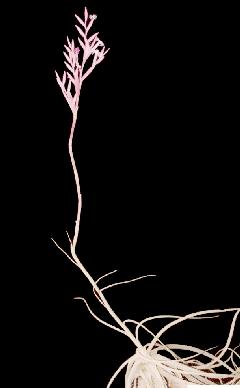
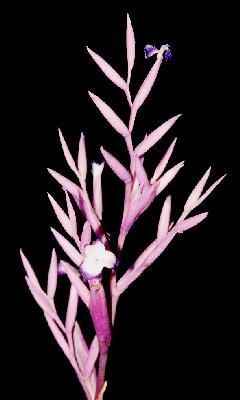
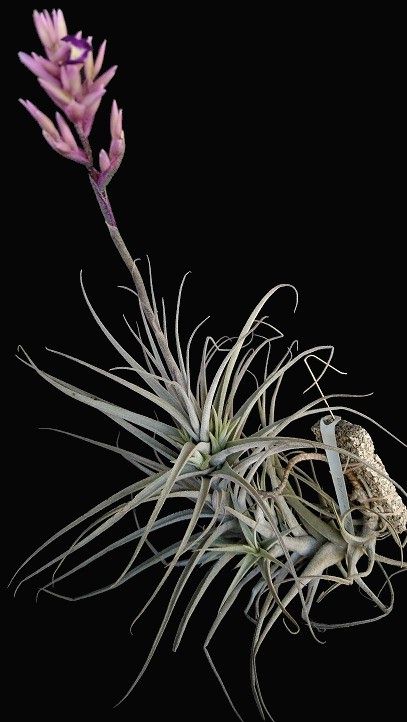
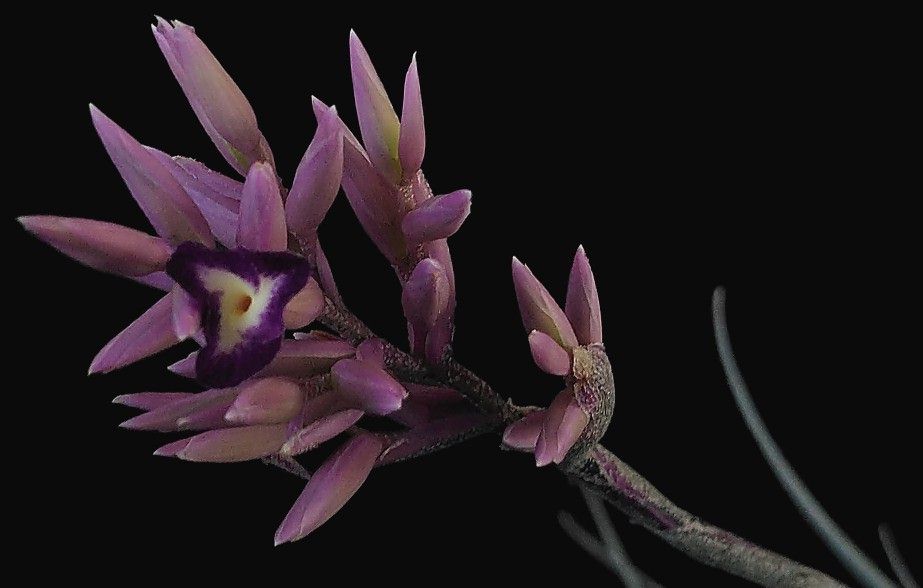
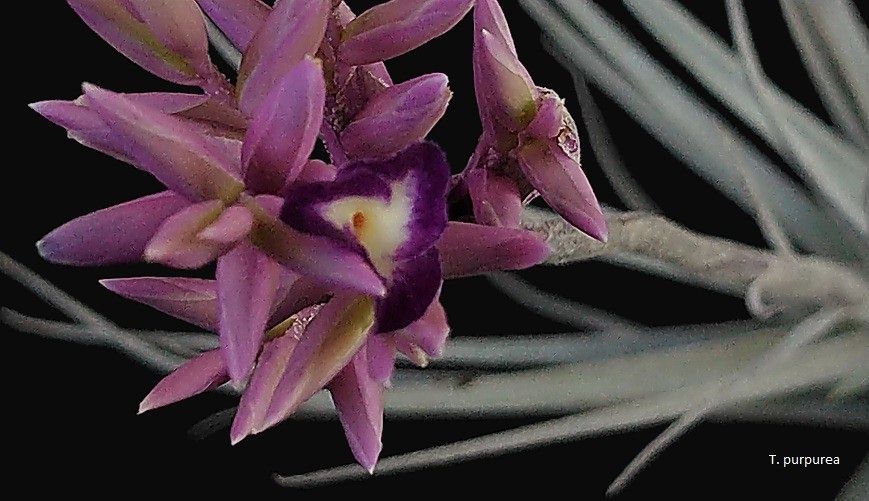

NOTE In Binomials 1 1990 and confirmed in DeRebus I 1994 T. purpurea and T straminea were split with no reason given. Therefore the description has been taken from Mez 1934. In Mez’s key the difference was shown as ‘Floral bracts less or equalling the sepals for T. straminea and floral bracts a little exceeding the sepals for T. purpurea’. BUT in his descriptions he has T. straminea bracts 18mm sepals 16mm, sessile? and T. purpurea bracts 12mm sepals 11mm with pedicel up to 5mm!!! Whereas Baker in 1889 says T. straminea has calyx reaching the tip of the bract and T. purpurea has calyx as long as the bract.
In California Brom trade 1998
purpurea = short stiff leaves (Mez rigid, 20cm x 14mm wide)
straminea = long lax leaves (Mez leathery, 25cm x 10mm wide)
Description from Mez 1934
Tillandsia purpurea Ruiz & Pavon, Fl. Peruv. 3: 41, pl. 270, fig. a. 1802.
Platystachys purpurea Beer, Bromel. (1857) 89.
Phytarhiza purpurea, Morr ex Bak. Bromel (1889) 167.
Tillandsia longebracteata Meyen (non Bak.) Reise II. (1843) 45.
Anoplophytum longebracteatum Beer, l. c. 264.
Plant clearly caulescent, up to 40cm long
Leaves all or the exterior ones barely decurved, up to 20cm long and 14mm wide, from linear tapering to a subfiliform tip, rigid, covered with large scales totally white or grey.
Scape slender, erect, dense membranaceous sheaths, lepidote, a little exceeding the internodes, narrow elliptic, the blades stretched tenuous filiform involute.
Inflorescence few flowered, sublax bipinnate panicle, up to 80mm long and 60mm diam., pyramidal,
Primary bracts lanceolate, lepidote, acute, shorter than the axillary spikes
Spikes well pinnate, up to 7 flowered, to 30mm long and 25mm wide, strongly geniculate
Floral bracts a little exceeding the sepals, membranaceous, glabrous, strong prominent veined, in no way imbricate, elliptic, slightly acute, the top portion sometimes minutely incurved, to 12mm long,
Flowers to 14mm long, suberect, sometimes the pedicels up to 5mm long,
Sepals almost equal, almost free, sub-membraneous, glabrous, prominently veined, elliptic, acute, to 11mm long.
Petals to 5mm longer than the sepals, blades oval, suberect, much exceeding the stamens,
Habitat near Lima ( Cuming 981 e.p., Dombey 142, Ruiz & Pavon, Wawra “ Donau” 2655 e.p.), near Islay ( Meyen), near Obrajillo ( Brackenridge ), near Palca ( Collect. Ignot. in herb. Mez)
Tillandsia straminea H B K. Nov. Gen. et Spec. I. (1815) 285
Tillandsia scoparia Willd. ex Roem. et Schult. Syst. VII. (1830) 1217
Platystachys scoparia Beer, Bromel. (1857) 265
Tillandsia azurea Presl, Rel. Haenk. II. (1835-36)124, t. 24
Platystachys azurea Beer, 1. c. 90
Description from Mez 1935
Plant stemless, to 50cm high.
Leaves by no means forming a bulbose rosette, to 25cm long, 10mm wide next to sheath, then tapering gradually to a long filiform tip, leathery, large lepidote, spreading, brownish pruinose.
Scape slender, erect, doubly exceeding the leaves, dense straw coloured sheaths, sub membranaceous, elliptic- lanceolate, the tip of the lower bracts threadlike and bent downwards, the upper ones much shorter, dense lepidote, involute.
Inflorescence many flowered, sub-digitate panicle, dense, to 9cm long, and 6cm wide.
Primary bracts elliptic-lanceolate, long acute, shorter than the spikes.
Spikes ca 6, 6-8 flowered, subsessile, subpinnate, to 6.5cm long and 3cm wide, sub-erect.
Floral bracts a little shorter than the sepals, sub-erect, not at all imbricate, to 7mm apart, sub-membranaceous, prominently nerved on the back, carinate towards the tip and a little incurved, wide elliptic-ovate, acute, to 18mm long.
Flowers to 2.2cm long, sub-erect.
Sepals anterior free, posterior pair connate to 2mm, sub-leathery wide hyaline margins, wide ovate-elliptic, becoming obtuse, to 1.6cm long.
Petals longer than the sepals by up to 5mm, blades sub-erect, rounded.
Stamens included
Habitat Peru, near Olleros (Humboldt and Bonpland n. 3496), near Huanuco (Haenke), Tal des Rimac, to the ruined walls of Cajamarquilla (Seler n.252). Ecuador; near Riobamba (Andre n. 4318)
Description from Rauh (1979)
Tillandsia straminea H B K., 1816
Plant stemless to short-stemmed, up to 50cm high
Leaves forming a rosette, up to 25 cm long, heavily grey-scaled
Sheath not clearly delineated
Blade narrowly lanceolate, about 1.4cm wide, long-tapered
Scape slender, upright
Scape bracts overlapping, narrow, scaled, with a thin, straw yellow blade
Inflorescence compound, seldom simple
Primary bracts lanceolate, naked, straw yellow, shorter than the loose spikes of 6 to 8 flowers
Floral bracts flared, oval-pointed, 1.8 cm long, as long as the sepals, keeled
Flower up to 2.2 cm long, white, with a blue edge, fragrant, enveloping the stamens
Habitat Southern Ecuador to central Peru, from the coastal desert up to 2,500 m. Can easily be confused with T. purpurea from which it differs by its straw yellow and naked primary bracts
Description from Ruiz & Pavon
TILLANDSIA purpurea. Ruiz & Pavon, Fl. Peruv. 3: 41, pl. 270, fig. a. 1802.
7. T. panicula polystachya rosacea , floribus distichis , petalorum laminis purpureis, foliis ensiformi-subulatis recurvis.
PLANTA perennis, prolibus numerosis, aggregatis, procumbentibus, radicantibus.
RADIX ramoso-fibrosa , fusca.
SCAPUS solitarius, pedalis, erectus, teres, simplicissimus, glaber, squamis alternis, subulatis, longis, canaliculatis; inferne latis, amplexicauli-vaginantibus, convolutis, a nodo ad nodum incanis.
FOLIA sibi invicem incumbentia, subvaginantia, ensiformi-subulata , canaliculata, divergentia, reflexa , bi-tri-palmaria, canescentia, squamulis furfuris instar densissimis.
PANICULA terminalis , rosei coloris , spicis 5-9 , alternis composita , bracteis ovatis, acutis , concavis , striatis, incanis.
SPICAE oblongo-lanceolatae, pedunculatae, multiflorae.
FLORES distichi, imbricati, sessiles, bracteis oblongis, concavis , roseis stipati.
CALYX oblongus, roseus; laciniis convolutis, striatis.
PETALA inferne convoluta, superne patentia, unguibus albidis, laminis obscure purpureis.
CAPSULA oblongo-cylindrica, acuminata, pallescens; valvulis interioribus extus levibus, intus purpureo-atris, nitidis.
SEMINA numerosa, fulvescentia, stipite papposo-piloso.
HABITAT in Peruviae saxosis et arenosis locis, copiose in Limae , Huarocheri et Cantae collibus et tractibus.
FLORET Junio, et Julio.
VULGO in Lima nuncupant Cardo de Lomas.
Explic. Icon . 1. Flos intcger. 2. Calyx. 3 Petala. 4 Stamina. 5 Calyx in fructu. 6 Capsula. 7 Eadem apcrta valvulas internas externasque, et semina manifestans. 8. Valvula cum seminibus basi convoluta. 9 Eadem basi expansa. 10. Semen cum pappo explicato. 11. Idem pappo obvolutum. 12. Idem setulis stipatum.
Translated by Butcher
7. Tillandsia with a pink many spiked panicle, distichous flowered, blade of the petal purple, leaves ensiform-subulate recurved.
PLANT perennial, numerous offsetting, prostrate, with roots.
ROOTS fibrous branching, brownish.
SCAPE solitary, a foot long, erect, tubular, simple, glabrous, bracts alternate, subulate, long, channelled; lower part wide, amplexicaul sheath, convoluted, from node to node hoary.
LEAVES alternately folded inwards and lying upon themselves, almost sheathing, ensiform-subulate, channelled, divergent, reflexed, 6-9 inches long, becoming grey, with very dense furfuraceous scales.
PANICLE terminal, pink coloured, spikes 5-9 , alternately arranged, bracts ovate, acute, concave, striate, hoary.
SPIKE oblong-lanceolate, pedunculate, many flowered.
FLOWERS distichous, imbricate, sessile, bracts oblong, concave, pink crowded.
SEPALS oblong, pink; lacinia convolute, striate.
PETALS lower part convolute, upper part spreading, claw white, blade obscure purple.
CAPSULE oblong-cylindric, acuminate, becoming pale; interior valvule outside light, inside dark purple, shining.
SEEDS numerous, becoming brownish, crowded with pappus hairs.
HABITAT in Peru located on rocks and sand, copious in Lima, Huarocheri et Canta gathered together.
FLOWERED June, & July.
Common in Lima named Cardo de Lomas.
Explanation of Icon. 1. Entire flower. 2. Calyx. 3. Petal. 4 Stamen. 5 Catyx in fruit. 6 Capsule. 7 Eadem apcrta valvulas internas externasque, et semina manifestans. 8. Valvula cum seminibus basi convoluta. 9. Eadem basi expansa. 10. Semen cum pappo explicato. 11. ldem pappo obvolutum. 12. Idem setulis stipatum.
Peter Tristram 02/18 ... "In nature there are Pacific coastal plants with succulent, relatively short leaves generally regarded as purpurea and mountain plants, usually epiphytic, with long, lax, softer leaves that are thought to be straminea.
Then there is cacticola, which I have seen growing with straminea in the Cochabamba area of northern Peru. You also find what could be purpurea in the high Andes and many in-betweeners.
Interestingly none of the plants with distinct branches with more imbricate fb (usually lax after anthesis) that we tend to call cacticola, are fragrant, whereas all of the purpurea and straminea forms I have come across, are. Food for thought. Great bunch of plants!!
Franz Gruber has an amazing collection of these species, from Peru and Ecuador – damned shame about the bloody Xylella restrictions!"